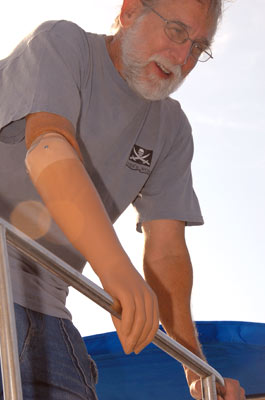Pre-Prosthetic Care – The Earlier, the Better:
Information is extremely important to the new amputee. Many people do not know what to expect or what to do before or after having an amputation. We have found an informed patient has a much easier time adjusting and their recovery is smoother.
For these reasons, we believe pre-prosthetic care should begin prior to amputation whenever possible. It is important to discuss the ideal amputation level, both medical and prosthetic, with your doctor. The sooner we get involved, the sooner we can fit you with your prosthesis. We are happy to discuss, in detail, the process of prosthetic rehabilitation.
The First Weeks Post Op:
Our Post Op management is different than most prosthetic clinics. We implement a team approach to expedite your speedy recovery. We start an immediate regimen of wrapping the limb using multiple elastic bandages. Most facilities apply a “shrinker” which is basically an elastic sock over the limb. While these are easy to use, we don’t feel they are the best choice.
We instruct the patient and/or caregiver on a very specific wrapping program to wrap and re-wrap the limb at least 6 - 8 times a day. This continuous wrapping serves to reduce edema (fluid) and atrophy the inactive muscles from the residual limb by keeping a “constant” tension. This tension cannot be achieved with a shrinker because as the residual limb loses volume, the shrinker loses tension. It also induces edema (swelling) at the end of the residual limb. When done correctly, residual limb wrapping can control edema and atrophy dormant muscles significantly faster than a shrinker. Proper residual limb wrapping has also been indicated to reduce phantom sensation.
Click here to view a video of the wrapping process
Additionally, the residual limb can be massaged and patted or tapped on to desensitize it, thus reducing the chance of discomfort while initially wearing the prosthesis.
We also recommend exercise and limb positioning. It is important to maintain strength in the residual limb as well as the rest of the body. When approved by your physician, exercises should also be performed to stretch the muscles of the residual limb and to prevent contractures from occurring. A contracture is a shortening of a muscle or muscle group, and is usually caused by inactivity. Once a contracture sets in, it becomes very difficult to bring the limb to a neutral position and makes the fitting and wearing of a prosthesis more difficult. A contracture can only be reduced with intense and sometimes painful stretching exercises. Therefore it is important to begin exercising as soon as possible after surgery. A medical professional should be consulted regarding an exercise program.
Your First Prosthesis
You may have heard of the term “preparatory or temporary prosthesis.” This term refers to the first prosthesis you will receive. The preparatory prosthesis is comprised of a socket with very basic, inexpensive components because of excessive volume loss during your first year post amputation. The traditional approach is to provide the patient with their first two preparatory prostheses. The traditional thinking is that in three to six months the entire prosthesis will be replaced with your final prosthesis using the more advanced components.
Our philosophy differs in that we start the patient off with the best components possible and simply revise the socket as needed. We find that patients respond significantly better physically and psychologically when they don’t have the frustration associated with ‘limiting’ components. Additionally, many patients acquire bad habits that are difficult to overcome when they use different components than they will ultimately end up using. We also want our patients to be rehabilitated as fast as possible and not to be limited by their prosthesis. If they are not using the most advanced components allowable for their prosthetic level, this provides significant limitations in our opinion. Our experience has shown us that using the “true” prosthesis from the beginning has a very positive effect on patient’s physical rehabilitation and their confidence.
Your Relationship With Us
Once you have been fit with your first prosthesis, we stay in touch to help you maximize your potential. In many cases, we work closely with a Physical Therapist who specializes in prosthetic rehabilitation and gait training. Some patients need only a few gait training sessions while others require more. As a general rule, higher amputation levels and patients that lose their limb at older ages require more gait training. There are however many other factors that must be evaluated on a case by case basis. Since prosthetic care is not a one-time service, but a rehabilitation program, it is important that we have a good relationship with you. We want to ensure you feel comfortable to express your needs and desires. Communication is the key to successful prosthetics rehabilitation, and we strive to make lasting and open relationships with all our clients.


